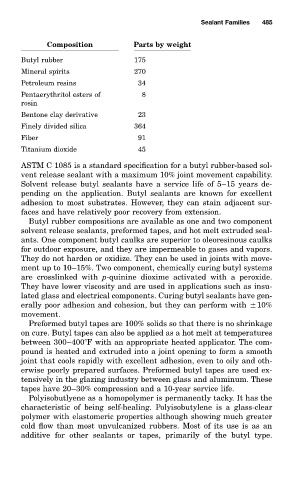Page 564 - Handbook of Adhesives and Sealants
P. 564
Sealant Families 485
Composition Parts by weight
Butyl rubber 175
Mineral spirits 270
Petroleum resins 34
Pentaerythritol esters of 8
rosin
Bentone clay derivative 23
Finely divided silica 364
Fiber 91
Titanium dioxide 45
ASTM C 1085 is a standard specification for a butyl rubber-based sol-
vent release sealant with a maximum 10% joint movement capability.
Solvent release butyl sealants have a service life of 5–15 years de-
pending on the application. Butyl sealants are known for excellent
adhesion to most substrates. However, they can stain adjacent sur-
faces and have relatively poor recovery from extension.
Butyl rubber compositions are available as one and two component
solvent release sealants, preformed tapes, and hot melt extruded seal-
ants. One component butyl caulks are superior to oleoresinous caulks
for outdoor exposure, and they are impermeable to gases and vapors.
They do not harden or oxidize. They can be used in joints with move-
ment up to 10–15%. Two component, chemically curing butyl systems
are crosslinked with p-quinine dioxime activated with a peroxide.
They have lower viscosity and are used in applications such as insu-
lated glass and electrical components. Curing butyl sealants have gen-
erally poor adhesion and cohesion, but they can perform with 10%
movement.
Preformed butyl tapes are 100% solids so that there is no shrinkage
on cure. Butyl tapes can also be applied as a hot melt at temperatures
between 300–400 F with an appropriate heated applicator. The com-
pound is heated and extruded into a joint opening to form a smooth
joint that cools rapidly with excellent adhesion, even to oily and oth-
erwise poorly prepared surfaces. Preformed butyl tapes are used ex-
tensively in the glazing industry between glass and aluminum. These
tapes have 20–30% compression and a 10-year service life.
Polyisobutlyene as a homopolymer is permanently tacky. It has the
characteristic of being self-healing. Polyisobutylene is a glass-clear
polymer with elastomeric properties although showing much greater
cold flow than most unvulcanized rubbers. Most of its use is as an
additive for other sealants or tapes, primarily of the butyl type.

